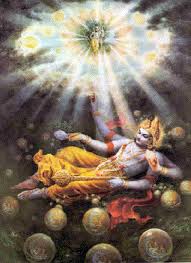Essence Of Maha Bhagavatha Purana |
|
 |
Original Propagation of Vedas After the discourse by Suka Muni to King Parikshth, who died of Daksha’s snake bite and King Janamejaya’s vengeful Sarpa Yagna and Brihaspathi’s counsel not to pursue the Sacrifice, Sage Suta took over the further Discourse at Naimisaranya to a congregation of Rishis headed by sage Saunaka. He explained that the Vedic Sound ‘OM’emanted from the Supreme Energy as the seed of all Vedic Hymns. Omkara emerged from the three original sounds of the alphabets- A,U and M. These three sounds represent three forms of Nature-Sat, Rajas and Tamasa; three Vedas-Rig, Yajur and Sama; three planetary systems-Bhur,Bhuvar, and Svah; and three functions of Universe-Creation, Sustenance and Destruction. |
Lord Brahma created other sounds of Alphabets, Consonants, and measurements and Time.The Sage Parasara and his spouse Satyavati begot Sage Vyasa, who was basically responsible to divide One Single Veda heard first from the four mouths / heads of Lord Brahma to four Separate Vedas and taught each of the Samhitas to separate Disciples: Rig Veda known as Bavrucha to Paila, YajurVeda known as Nigada was passed on to Vysampayana, Sama Veda known as Chandoga Samhita to Jaimini, and Atharva Veda to Sumantu. Paila gave two parts each to Bhaskala and Indrapramiti. Bhaskala passed on one part each to Bodhya, Yajnyavalka, Parasara and Agnimitra. Indrapramiti taught his part of the Samhita to Murdyuka. This was further taught by the latter to Devamitra and further in the line to Saubhari. Down the line, Sakalya added his own version of the Samhita and taught one half of it to Vatsya, Mudgala, Gokhaya and Sisira.Another disciple of Sakalya Jaturnya added a Vedic Glossary to the total collection of Rig Veda. There was however some problem in the evolution of Atharva Veda given to Sumantu. In his lineage, Sage Vysampayana and his disciples became authorities of the Veda.These disciples were known as ‘Charakas’, as they were under instuctions from their Teacher to relieve him of a sin to have killed a Brahmana. Thus one of his students Yagnavalkya suggested that he himself could perform a severe sacrifice to relieve of the Guru of the sin.Vysampayana grew angry and asked Yagnyavalka to vomit whatever was taught to him and get out. Yagnyavalkya approached Lord Brahma directly through hard penance and obtained valuble Yajur Mantras never known earlier and the Sage compiled fifteen new chapters known as Vajasniya Samhita, since Sun God personally delivered the new Mantras riding a horse and the hairs on the mane of the horse. The Yajur Mantras omitted by Yajnyavalka which were sought by other disciples assumed the forms of partridges and picked up the remains and hence the name of Titheriya Samhita which are popular till date. As regards Sama Veda, Jaimini who was taught by Vyasa Maha Muni, and the former taught the entire Veda into three parts, of which one part each was taught to his son Sumanthu, grand son Satvan as also to his disciple Sukarna.The three of them distributed their parts to thousands of disciples some targetting the northern and eastern parts of Bharat mainly. Besides Vedas, there are Eighteen Puranas or historical records of Events highlighting Specific Instances through Ages and Yugas, underlining the interaction between Maya and the Supreme Energy.The Puranas are Brahma, Padma, Vishnu, Siva, Linga, Garuda, Narada, Bhagavata, Agni, Skanda, Bhavishya, Brahma Vivarta, Markandeya, Vamana, Varaha, Masya, Kurma, and Brahmanda. |
|
| Maha Bhagavatha Purana Home |  |
Back to the News Page